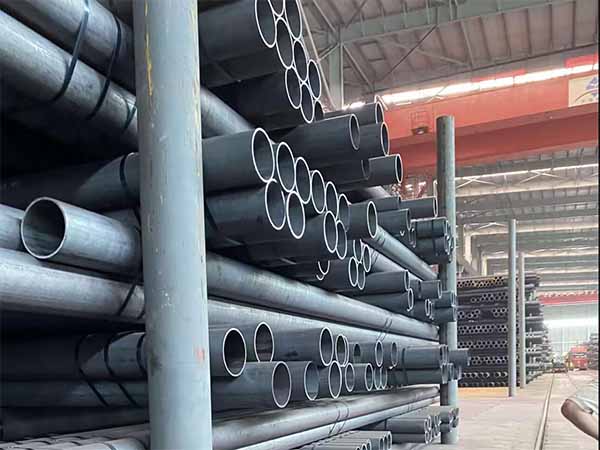
Among common wall thickness standards: SCH 40 is usually referred to as standard wall thickness (STD, Standard Weight); SCH 80 corresponds to extra strong wall thickness (XS, Extra Strong), which can withstand higher pressure.
SCH 40 vs SCH 80 Steel Pipe Pressure Rating
|
Nominal Pipe Size (NPS) |
Outside Diameter (OD) |
Schedule 40 Wall Thickness |
Maximum Pressure (PSI) |
Schedule 80 Wall Thickness |
Maximum Pressure (PSI) |
|
1/8" |
0.405 |
0.068 |
810 |
0.095 |
1230 |
|
1/4 |
0.540 |
0.088 |
780 |
0.119 |
1130 |
|
3/8 |
0.675 |
0.091 |
620 |
0.126 |
920 |
|
1/2 |
0.840 |
0.109 |
600 |
0.147 |
850 |
|
3/4 |
1.050 |
0.113 |
480 |
0.154 |
690 |
|
1 |
1.315 |
0.133 |
450 |
0.179 |
630 |
|
1 1/4 |
1.660 |
0.140 |
370 |
0.191 |
520 |
|
1 1/2 |
1.900 |
0.145 |
330 |
0.200 |
470 |
|
2 |
2.375 |
0.154 |
280 |
0.218 |
400 |
|
2 1/2 |
2.875 |
0.203 |
300 |
0.276 |
420 |
|
3 |
3.500 |
0.216 |
260 |
0.300 |
370 |
|
3 1/2 |
4.000 |
0.226 |
240 |
0.318 |
350 |
|
4 |
4.500 |
0.237 |
220 |
0.337 |
320 |
|
5 |
5.563 |
0.258 |
190 |
0.375 |
290 |
|
6 |
6.625 |
0.280 |
180 |
0.432 |
280 |
|
8 |
8.625 |
0.322 |
160 |
0.500 |
250 |
|
10 |
10.750 |
0.365 |
140 |
0.593 |
230 |
|
12 |
12.750 |
0.406 |
130 |
0.687 |
230 |
|
14 |
14.000 |
0.437 |
130 |
0.750 |
220 |
|
16 |
16.000 |
0.500 |
130 |
0.843 |
220 |
|
18 |
18.000 |
0.562 |
130 |
0.937 |
220 |
|
20 |
20.000 |
0.593 |
120 |
1.031 |
220 |
|
24 |
24.000 |
0.687 |
120 |
1.218 |
210 |
What factors determine the rated pressure of a pipeline?
The rated pressure of a pipeline refers to the highest internal pressure that a pipeline can fully withstand at a specific temperature. Many factors influence pipeline pressure; the following are some of the most critical determining factors in engineering design:
1. Wall Thickness (Direct Factor)
The thicker the pipeline wall, the stronger its pressure-bearing capacity. Different grades such as SCH 40, SCH 80, SCH 160, and XXS correspond to different wall thicknesses. Thicker walls are less prone to deformation or rupture under pressure.
2. Pipe Material
Different materials have different strengths and allowable stresses. For example:
Carbon steel (ASTM A53, A106) → Commonly used for medium and high pressure
Alloy steel (ASTM A335) → High temperature and high pressure environments
Stainless steel (ASTM A312) → Corrosion resistant and temperature difference resistant
Duplex stainless steel, nickel-based alloys → Used in extreme conditions
The yield strength and tensile strength of the material directly affect the pressure rating.
3. Temperature
As temperature increases, the allowable stress of a material decreases. Engineering standards typically specify allowable stress values at different temperatures. Proper temperature control can significantly improve the material's compressive strength.
4. Manufacturing Method
Steel pipes are manufactured in two ways: seamless manufacturing and welded manufacturing.
Seamless steel pipes: Without weld seams, they have higher overall strength and are suitable for high-pressure applications.
Welded pipes: Have weld seams, resulting in lower overall strength. The weld seams are significant weak points, making them unsuitable for high-temperature and high-pressure applications.
The rated pressure of a pipeline is not determined by a single factor but by a combination of factors, including wall thickness, material, temperature, outer diameter, manufacturing process, design standards, and corrosion allowance.
Summary
SCH 40 and SCH 80 pipes have the same outer diameter but differ in wall thickness, weight, and pressure rating. SCH 80 offers higher pressure resistance and is ideal for harsh industrial environments, while SCH 40 is suitable for general applications.